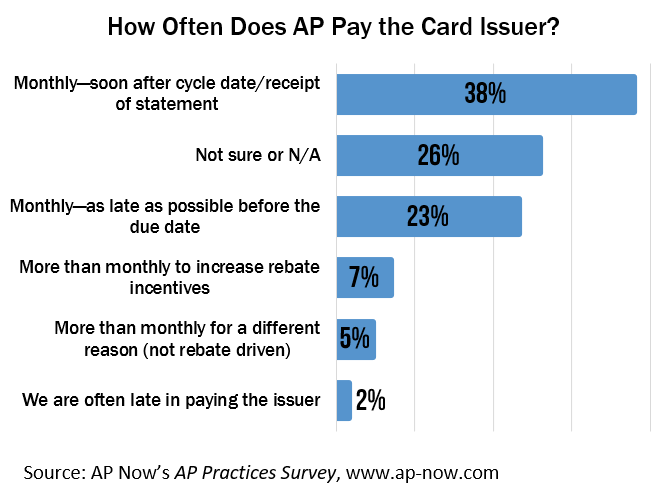Even if your Purchasing Card policies and procedures (P&P) manual is current, it could be lacking in other ways, resulting in repeated questions and compliance issues. Have you evaluated the manual’s topics and related content recently? It might be missing key information. Yet, reviewing and updating P&P often fall to the bottom of someone’s to-do list. According to AP Now’s AP Practices Survey Results, fewer than 20% of respondents update their accounts payable P&P at least annually. I assume the same could be true for P-Card P&P. To help you gauge whether you are covering the right material, following are 12 broad topics along with example sub-topics for some.
Primary Topics
1. P-Card Overview
Relay what P-Cards are, why the organization has a program, what P-Cards are used for, etc.
2. Roles and Responsibilities
3. How to Obtain a P-Card
4. Card Security and Limits
Be sure to provide insight on common scams/external frauds and how to combat.
5. Card Usage
This broad category spans many sub-topics, such as:
Allowed and prohibited purchases, including parameters describing “necessary” versus “extravagant” business purchases
Preferred/approved vendors
Placing an order—the P-Card purchase-to-pay (P2P) process
Supporting documentation requirements
Returning an order and receiving credit
Accidental usage for a personal purchase
What constitutes card misuse/abuse
6. Transaction Declines
Explain why this might happen and what to do in response.
7. Transaction Reconcilement and Review
One relevant sub-topic is how cardholders should address a problematic transaction; see the previous blog post for tips.
8. Ongoing Training Requirements
9. Card Expiration and Renewal
10. About Program Auditing
While you do not need to give away any secrets, you do want program participants to know that transactions are monitored.
11. Card Cancellation
12. Reference Materials
Examples include a glossary, user guide for the P-Card technology, relevant forms, etc.
Concluding Thoughts
While it is nearly impossible within the P&P to address every unique situation that could arise, think about what you experience on a regular basis, such as frequently asked questions and common mistakes. Respond to these experiences by planning to make the related content clearer, more prominent, and easier to find. Taking the time to make your P&P more robust can pay off.
Additional Resources
See more content on P-Card policies and procedures from Recharged Education, including a related guide available for purchase for just $29.99.
For more information about AP Now’s AP Practices Survey Results referenced in the introduction above, visit http://www.ap-now.com/products/item142.cfm.
Available Products & Services from Recharged Education
Submit a contact form to request a quote for what your organization needs.
Subscribe to the Blog
Receive notice of new blog posts.
About the Author
Blog post author Lynn Larson, CPCP, is the founder of Recharged Education. With 20 years of Commercial Card experience, her mission is to make industry education readily accessible to all. Learn more…




